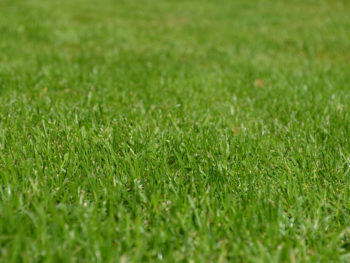White clover is a very easy weed to recognise, and you may have spent countless childhood hours hunting for the four-leaf version. While that can be a fun challenge, eradicating a clover infestation from your lawn is not.
A common weed in Australia, clover has the very recognisable three green serrated leaves topped by white, ball-shaped flowers and creeping stems. Clover is a legume plant that draws nitrogen from the air to store in its roots. It spreads easily throughout lawns via stems attached to the soil which grow into new plants. Clover is a winter-germinating weed, and will thrive and spread in spring when soil temperatures are mild and warm and plenty of sunlight reaches the soil surface.
Clover can often be quite difficult to get rid of, as it reseeds itself every year and will continue to come back. It spreads easily in a few different ways, and can even propagate from its own clippings.
Why some people want clover in their lawn
On a side note, it might surprise you to know that some people actually choose to add clover to their lawn. This is due to the fact that clover prevents weeds, fertilises your lawn by adding nitrogen, attracts bees, is soft to walk on, makes your lawn appear greener and shades the soil well. In fact, back in the 1950s and 60s, the optimum lawn mix was around 20% clover. For all these reasons, many people encourage the growth of clover in their lawn and even add in additional microclover to give more uniform clover coverage.
However, if you prefer the look of a smooth, velvety lawn without the distraction of clover flowers and wide leaves, you’ll need to thoroughly remove this prolific weed. Here’s how to do it.
How to remove clover
The most effective method of preventing clover from dominating your lawn is to maintain a dense and healthy lawn. Thick lawns are more easily able to crowd out weeds such as clover and prevent them from taking hold. (For one of the best weed-resistant lawns around, have a look at Sir Walter Buffalo turf here).
There are also a few strategies you can try to get rid of existing clover in your lawn without using herbicides.
Feed you lawn well
Clover will flourish in lawns which have low nitrogen and fertility levels. Unfertilised grass gives clover an advantage – as it can produce its own fertiliser, whereas grass can’t. If there is sufficient nitrogen in your soil to keep your lawn healthy, the clover will struggle to survive. Clover will be much less of a problem if you fertilise your lawn with a good organic fertiliser during spring to ensure optimum nitrogen levels. To see Horsham Turf’s range of lawn fertilisers, click here.
If you’re not sure about your soil’s nitrogen levels, you can conduct a pH soil test to determine if nitrogen is lacking, or take a soil sample to your local lawn care provider to find out the same thing.
Mow high
It can be tempting to set your mower blades lower than normal to scalp the clover, but this will only stress your grass instead. Low-growing clover with its shallow roots has no problem being mowed short, although your grass won’t love it. Mow high and leave your lawn over 3 inches tall, to give your grass the advantage. The longer grass will shade the weed and prevent it from growing.
Remove it by hand
Clover can be removed by digging its roots out of the soil with a gardening tool or fork, or with a sharp knife. Make sure you carefully remove the weed from the lawn area (you could use a plastic bag for this) so that it doesn’t re-propagate from discarded pieces. Loosen the soil around the plant to break up any remaining stubborn roots and make sure you get everything out. Clover will begin to spread and grow in spring, so try and remove it before it flowers.
Organic treatment
There are a number of organic weed killers on the market which will kill the weeds in your lawn without harming the grass. If you’re treating organically, make sure your lawn is well watered once or twice a week. For a DIY solution, you could also try pouring white vinegar onto the weed and the soil.
Chemical treatment
Pulling weeds might be doable in small lawns, but if you have a large area of grass, this may not be practical. If all else fails and you have to resort to chemicals, clover can be effectively killed with a broadleaf weed or clover-specific selective herbicide sprayed onto the lawn. Available at your local garden supply store, these will do the job quickly and easily. You must use the correct product for your type of lawn though, so consult your local lawn care professional for advice. To check out Horsham Turf’s range of weed treatment products, click here.
Make sure you read the label for the specific details on how much you should apply and the appropriate aftercare treatment. If you’re unsure whether your lawn will tolerate chemical treatment, apply the herbicide to a small, out-of-the-way section of your lawn and monitor it over a few weeks. If there are no problems, go ahead and treat the entire lawn.
Clover infestations are quite controllable with a little bit of care and effort. Spring is the time to get on top of this dominant weed before it spreads and becomes a bigger problem. Give these strategies a try now and you’ll be enjoying a clover-free lawn over summer.
For more tips on how to spring clean your lawn, click here.





 Spring cleaning your lawn
Spring cleaning your lawn
